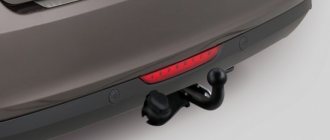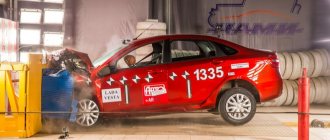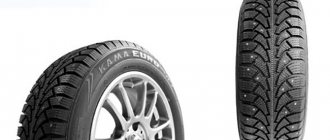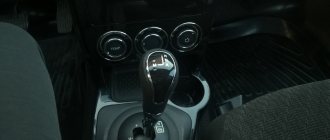Features of the robot's behavior after running in
As a rule, after running-in, the robot and the driver adapt to each other. The driver already automatically starts the engine from the neutral position of the lever and simultaneously presses the brakes. Gear changes have returned to normal and become shifts without interruption in the power flow or without "jerking".
Some reviews regarding the “behavior” of the robot after running-in recommend not to “fall” on the gas pedal when starting to move, trying to quickly gain speed to switch from the initial speed to the next one. This manipulation does not give the desired effect, however, the transition from second gear to third and subsequent transitions will be carried out much faster, unless, of course, you reduce engine speed by releasing the gas pedal.
In traffic, it is recommended to accelerate within the appropriate gear for the traffic flow, which makes driving as economical as possible. In this case, the gas pedal can be used to control the robot, indicating the engine speed at which switches it needs to make.
Features of the robot's future behavior
At the beginning of 2021, VAZ conducted surveys of users of cars with an AMT robot, probably noticing that many complaints were coming from car owners living in megacities, who are under the threat of regularly getting stuck in traffic jams, where the gearbox shows not entirely favorable “behavior.” And all this is due to the lack of the so-called “creeping mode”.
If we consider the conditions of being stuck in traffic jams, there are only two types of traffic jams:
- The first type is a standing traffic jam, where traffic occurs in the mode: drive 5-10 meters and stop. In this mode, judging by the reviews, the gearbox robot behaves quite well: the driver pressed the gas pedal - it moved smoothly and began to move, released the gas pedal - it stopped.
- The second type of traffic jam is when the flow of traffic moves at walking speed, where the notorious “creeping mode” is required. In this case, it is difficult for the driver to select the engine speed not in the first gear of the gearbox in order to move synchronously with the flow of cars in a traffic jam, since when adding gas, the gearbox takes a pause while the car is still rolling, and then begins sharp acceleration, while the driver releases the gas pedal and clutch turns off, etc. If you look from the side, the car moves jerkily.
According to yet unconfirmed information, it is precisely this problem of the AMT’s lack of a “creeping mode” that the VAZ developers plan to solve.
The AMT gearbox is not as popular as a manual or automatic transmission, although it combines both types of transmissions. What is it, what types of AMTs are there and how to ride them?
To transmit torque from the engine to the wheels, the car has a special device - a gearbox or transmission.
It can be mechanical, automatic, robotic or CVT.
The first three are stepped, that is, they have the usual first, second and other speeds, the last is stepless and works on a different principle.
The AMT gearbox is installed on many modern cars, including Russian-made cars.
Advanced models of such gearboxes are also found on sports cars.
There is an opinion that in the future AMT will become more widespread than automatic transmissions and will completely replace manual transmissions.
A completely different Xray
An Xray Cross with a new “robot” AMT was brought to a special event organized for members of the jury of the Top 5 Auto automobile award. And, as it turned out, by mistake. The car was removed from the test, citing the fact that it was a pre-production sample, and the updated AMT gearbox was offered to be tested on the Vesta.
Until recently, the Xray crossover was the most expensive model of the Lada brand, based, albeit on a foreign, but simple Renault platform - from Logan and Sandero. While working on the even more expensive Xray Cross, in Togliatti they decided to seriously modify the truck that AvtoVAZ had inherited - its inherent shortcomings for such a car were already becoming critical.
Xray Cross
Xray Cross
Photo: Lada
For example, the hydraulic booster lacked performance, causing the steering wheel to receive shocks from bumps. That's why the off-road Xray has a completely new electric boost and a new rack. Due to the increased ground clearance to 215 mm and a wider track, the suspension was completely redesigned, using a bizarre mixture of parts from Vesta and Duster. The same is with the brakes - discs from Vesta Cross on the rear axle instead of drums and a more powerful vacuum booster from Renault Duster.
MIAS 2018: the brightest and most anticipated automobile premieres
Manufacturers from Russia and China took the lead
By the way, Steve Mattin insisted on increasing the track - due to the plastic body kit, the car body became wider and without widely spaced wheels the Cross version would not have looked so harmonious. Harmony was added by 17-inch wheels and an off-road body kit - it performs not only a protective function, but also an aesthetic one. In any case, compared to the athletic Cross version, the Xray seems heavy and clumsy.
General information about the AMT robot
- The mechanical part is based on a five-speed modification of the VAZ model 2180 gearbox. Moreover, this gearbox is equipped with gear pairs with different output ratios for different Lada models. For example, the Vesta box has this output indicator of 3.9, when, as on Grants and Kalinas, it is 3.7.
- You cannot take an actuator (clutch pressing mechanism) and robot electronics and put it on a regular box of the same VAZ 2180 model so that the result is a robot. Although the reverse procedure of replacing a robot with a mechanical one can be carried out with overcoming some obstacles.
- It is believed that the actuator cannot be repaired or maintained, but this is not for our craftsmen. Cases of its failure, judging by the reviews, are very rare. Usually, they happened at the beginning of operation, while still under warranty. There were no cases of refusal to replace.
- The recommendation to change the oil in the AMT at a mileage of 120 thousand does not stand up to the criticism of mechanics; they recommend doing this at 75 thousand mileage.
- The adaptability or adaptability of the transmission to changing operating conditions of the engine and its load, the position of the gearbox engaged mode sensors (ECP), as well as the gas and brake pedals is ensured by reading the sensor information and analyzing this information. And based on the algorithms embedded in the robot’s program, a certain order of its actions is formed. In this case, the driver’s actions in various situations are taken into account, which are stored in the robot’s long-term memory. If we say all this in a simple and understandable language for everyone, then the AMT transmission adapts to the characteristics of the driving style of a particular driver and road conditions. Moreover, for this she usually needs a couple of tens of kilometers of driving in the city.
- The AMT robot is sensitive to engine load and quickly responds to the activation of maximum torque. At the same time, each subsequent gear can be engaged only when the engine speed drops below 2.5 thousand, and each subsequent one when the range from 4 to 4.5 thousand revolutions is reached. In addition, the degree of load perceived by the engine is taken into account. For example, on a slope, the AMT robot will switch to a lower gear if the load on the engine decreases, but will leave it in the most economical operating mode.
- AMT has its own peculiarities of operation in accordance with the established transmission modes. For example, in “M” mode, the gearbox switches faster compared to “A” mode.
How does a manual transmission work?
Home » News
Published: 07/30/2017
All-round view – Problem: automatic transmission, robot or CVT?
Everyone knows that there are two main types of transmissions used in cars - manual and automatic transmissions.
However, there is a whole range of gearboxes that combine some of the operating principles of manual and automatic transmissions. One such transmission is the AMT, which is also an automated manual transmission.
This name is already quite widely known among motorists, but many still have the question: “What is this - an AMT gearbox?”
Not all motorists currently understand the difference between an automated transmission, which is AMT, and a pure “automatic”, which is familiar to the car owner. In this article we will look at the basic principles of operation of the AMT transmission, its differences from an automatic transmission (many car enthusiasts confuse them), as well as its pros and cons. Automatic transmission, robot or CVT. Which is better?
General characteristics and device of AMT
In fact, AMT has much more in common with a manual transmission than with an automatic transmission, as can be seen even from the decoding of the name (AMT - automated manual transmission). Essentially, this is the same mechanics, which is controlled using a special control unit. ROBOT BOX
Advantages and disadvantages of the robot on Vesta
The advantage of a robot over mechanics: convenience, because Only one leg is occupied, both hands are on the steering wheel.
The advantage of a robot over an automatic: it is more economical (What is the fuel consumption?) than a conventional automatic, you can tow a car, slipping is allowed on the roads, the dynamics of the “mechanics” are preserved.
It is also worth noting that the robot has protection against “crooked hands”. In other words, randomly switching the robot selector while driving will not cause any damage. In addition, Priora, like Vesta on a robot, can be started from a pusher, you can drag a trailer, tow a car - you just need to switch to mechanical mode.
The first robots were installed on the Lada Priora with a 1.6 liter engine producing 98 hp. But the robot has already been reprogrammed for the new 127 engine, paired with which Vesta will be produced.
When slipping during the start, for example, on snow, the AMT can engage both second and third gear.
Possible hang-ups in gear, for example, after speed bumps, the robot will not immediately engage second. In this case, you can switch to manual switching mode.
Let's start with the advantages. According to reviews of the robot on Vesta, the machine has the following undeniable advantages:
- Equipped with the “Slope Start Assistant” program – even if you park or get stuck in a traffic jam on a slope, this option will help you avoid rolling back when starting. The gearbox increases speed at the start, the clutch becomes stiffer.
- Increased clutch life - thanks to the soft and smooth operation of the AMT, the service life of the part will be long even with careless driving. The shift box is protected against accidental pressing of the lever: if you start shifting it chaotically, the car simply will not react.
- AMT is adaptive and has 26 behavior patterns that it selects depending on the driver’s behavior. How it works? The program reads how the driver operates the gas pedal and, depending on this, switches the clutch at the right moment.
- Fuel economy is hard to believe, but the robot on the Lada is really more economical than a manual or automatic transmission. Thanks to smooth switching, you can use several times less gasoline.
- AMT consumes less oil than manual transmission - also a significant factor in favor of choosing a new configuration.
See about copters: Robots and people: safe cooperation
Reviews of the robot box on Vesta also show the disadvantages of an automated manual box:
- The absence of a parking mode makes parking more difficult; when parking, it is better to leave the control lever in manual or automatic mode to avoid rolling back.
- Gear changes are jerky - between 1st and 2nd gears there is a decrease in speed, which can noticeably slow down the car.
- Slow acceleration - a car with AMT takes a few seconds longer to pick up speed than a car with a manual transmission.
- The inconvenience of the manual mode is that the gearbox is not designed very well, and this makes manual driving of the car less convenient.
Why did it happen that it has changed now?
Theoretical basis
The basis of the CVT gearbox is a 5-speed manual transmission from VAZ, but it is equipped with actuators from ZF from Germany. The Lada robot box was first released back in 2014 and installed on the Priora, then gradually moved to the Vesta, which needed 2-pedal versions, as if in the air - after all, the car’s competitors are foreign cars, while consumers do not like manual gear shifting .
The Lada robot box did not go well with its status.
However, Lada specialists replaced the firmware, conducted experiments with the clutch, then made a significant change in 2018, which was announced simultaneously with the release of the Vesta Cross sedan, but during a test in May these cars simply...disappeared.
For this reason, the wait dragged on until November.
Features of operation
In accordance with the reviews, a list of custom features of the AMT transmission has been compiled:
- Unlike an automatic transmission, AMT does not have such a mode as “parking” or “P”. Therefore, reviews recommend leaving the AMT in gear when parked, turning off the engine in mode “A” or “R”. And with the engine not running, move the lever to “N” mode, but even in this mode the gear will be engaged. When the ignition is turned on, the speed will automatically turn off. Therefore, you need to remember this feature of the AMT, and to prevent the car from rolling, in this case the car is fixed with the brake pedal. Moreover, the car will not start without pressing the brake pedal. Which some car enthusiasts point out as a disadvantage, and others as an advantage that increases the safety of starting the engine when the speed is accidentally turned on, for example, as with a manual transmission;
- Unlike simple mechanics and an automatic transmission, AMT will not move the car at idle speed, that is, driving at idle speed is impossible. To start moving smoothly, you need to add engine speed by pressing the gas. What is indicated as a disadvantage in reviews from residents of megacities, who often find themselves stuck in traffic jams. Therefore, for those who periodically encounter traffic jams, during short stops it is recommended to switch the lever to the “N” mode, because after a minute of parking with the brake pedal not pressed, the switch will disconnect the clutch by pressing the release lever, which can subsequently negatively affect the release bearing . However, some reviews provide examples of the opposite opinion, that this has absolutely no effect on the condition of the release bearing;
- There are many opinions in the reviews about braking using AMT. When braking the engine by resetting its speed, the AMT reacts quite sensitively in higher gears by switching to lower ones, but many recommend doing this in combination with the brake pedal depressed. Regarding smooth braking with the help of brakes, AMT “helps” to brake by switching lower gears. But during heavy braking, the AMT completely disengages the clutch. But in some reviews there are stories about some “sagging” of the brake pedal in these cases.
- after sharp braking, the clutch remains open until the engine speed is increased by the gas pedal;
- When you apply emergency braking using the brake pedal, the Brake Assist System (BAS) is activated and the clutch is instantly released.
Brief instructions for operating the robot
How to use the new gearbox? Reviews from owners of the Lada Vesta 1.8 robot indicate that you still need to learn how to use the AMT. The car's on-board computer displays information that helps monitor the operation of the transmission:
- Mode (manual/automatic).
- Active transmission.
- Brake pedal activity.
So how do you start a Lada Vesta with AMT? To do this you need to follow a number of simple steps:
- Press the brake pedal.
- Move the shift lever to the neutral position.
- Start the car.
Another useful feature of LADA with AMT is that it can be started from a pusher. Rope launch is activated at speeds of 7 km/h and above. The car also has a transmission brake function. When rolling down an inclined surface, it is permissible to use the brake pedal for more effective braking. All these useful modes make operating the Lada Vesta with AMT convenient and comfortable.
Unlike the automatic, there is no P-parking selector position. This is why we put the car either on the handbrake (which can cause the drum to freeze in winter) or on speed.
We start the car in the “neutral” position with the brake pedal depressed.
Features of running in with a robot
In the reviews, especially from those who recently got behind the wheel of a Lada with an AMT robot, there is a lot of talk about how the robot is supposedly “dumb.” But there is a simple explanation for this supposedly “freezing” AMT. In the process of getting used to a new car, any driver, even impudent in other cases in relation to cars, does not “fall”, so to speak, with all his weight on the gas pedal.
He tries to drive the car like a pensioner, driving at low and medium speeds. Moreover, if, according to the AMT gear shift conditions, each subsequent gear is engaged when the engine reaches 4.5 thousand revolutions, then in this case this driver will not wait for the AMT to engage an upshift. This is the whole reason for the “stupidity” of AMT. In response to such statements, one can suggest that such drivers first “use” their brains, and then give the car gas. And immediately everything will fall into place.
How much does a robot cost?
Automatic and manual transmissions The new product has two transmission options: domestic automatic and French manual. Since many tests of the car were carried out (automatic test drive video below), we can confidently talk about the pros and cons of the first and second gearboxes.
The global market has shown that the frequency of implementation of AMT in vehicles is beginning to fall, this is due to the following factors:
- the mechanism operates with small and unauthorized delays, which makes the driver very nervous;
- the robot switches gearbox gears quite sharply, this is noted by a large number of owners who have a colossal love for dynamic driving;
- The robot does not reduce gears in a timely manner on slopes, and when driving up a mountain in reverse, it excessively “rips” the gears.
Robotic gearboxRussian designers decided to take a risk and create their own robot with five stages, relying on the following advantages:
- Production is cheaper than designing a manual transmission and an automatic transmission. On the dealer market, a “robot” costs about 20,000 rubles, which is two times cheaper than an automatic transmission (automatic transmission).
- The fuel consumption of a Lada Vesta automatic or robot is significantly reduced.
- There is no need for frequent diagnostics and repair of the robot.
- The mechanism has built-in protection against unauthorized engagement of the gear at any speed.
- The automatic transmission consumes three times more oil than the Lada Vesta robotic gearbox.
- During driving there is no vibration of the lever, smooth clutch is ensured even during sudden pressure on the gas pedal.
See about copters: Tiki business - fork scanner, express, robot
In their development, domestic designers took into account the experience of foreign engineers and began to use German actuators (actuators), as well as French-made clutches in their transmissions. An option for clutch wear compensation is installed inside the AMT Lada Vesta. In addition, it does not need to be warmed up before starting work. An automated manual transmission weighs much less than an automatic transmission, which reduces gas mileage when driving.
If you are interested in the question of whether it is worth buying a robot, we will tell you: sign up for a TEST DRIVE, because it is free. Only by experiencing the robot’s operation yourself will you be able to understand whether it is suitable for you or not. If it doesn’t fit, then a manual transmission package is waiting for you.
AvtoVAZ says that the gearbox is suitable for everyone; AMT has 20 different switching algorithms. But this is not entirely true.
A little from myself: If you have a harsh character and you need appropriate behavior from a car, a robot is not for you. The robot is designed for calm, leisurely driving at medium speeds with smooth shifts and saving fuel and the clutch disc. And the question immediately arises of how this transmission will perform on Vesta Sport: how much the settings will be changed, whether sportiness will appear, etc.
If you want to buy a car ex-showroom, then the Robot will be 25 thousand rubles more expensive than a manual one. and that's not much. If we take the repair of the Gearbox by replacing all the elements, then the price tag will be in the region of 50-60 thousand rubles. Is this too much? No! Let's take a look at the competitors: An automatic Kia Rio and Solaris costs 300 rubles. The difference is colossal.
What changes have occurred
There are no changes in terms of hardware. However, the head of the entire project, V. Petunin, claims that cooperation with the clutch supply company Valeo is currently ongoing, the result of which should soon be the selection of the best composition for the friction lining. They are produced here, at the Valeo plant in Tolyatti, from here they are supplied with VAZ products.
Now the AMT Lada robot box is installed on the new Grant and West series with 1.8 liter engines. This gearbox is expected to appear on the XRay car soon.
However, the program with which control is carried out has been improved. Optimization of programs made it possible to reduce the time during which a gear switches from 1st to 2nd, as well as from 2nd to 3rd - by almost 30 percent (the synchronizer from Germany should withstand this), a special mode for traffic jams appeared, allowing the vehicle to move when the brake pedal is released. This ensures a smooth start.
Petunin spoke about common complaints from car owners who do not know how to correctly switch the robotic gearbox of the Lada Vesta, who stand in traffic jams for a long time or drive at maximum load in difficult situations. Many such motorists contacted the dealership, claiming that they had a transmission error light.
However, the instructions indicate that this indication is not critical; the temperature sensor is simply activated (the clutch becomes seriously heated during constant closure and slipping).
According to him, no standard situation on the road will lead to the car stopping. This is not bad, since, for example, many foreign automatic transmissions required constant throwing into the neutral position during stops or allowed the clutch to open during overheating, which is why they stood on the emergency warning light until it cooled down.
An algorithm has been added that allows you to accelerate on slippery surfaces in winter, but this requires the CVT transmission to switch to manual mode with the selection of 2nd gear (there is no separate button here). There is also a sports mode for the AMT Lada robot box, but the test failed because it has not yet been completed and is not available in existing cars.
Road characteristics
The missing sports mode of the auto transmission is not at all the main disadvantage of this gearbox. Taking the key to the Vesta Cross, which has a 1.8-liter engine installed, I initially noted that maneuvering in the parking lot was simplified, since there was no need to constantly “push” the gas pedal.
However, a very smooth start from a standstill causes vibration, which then manifests itself in congestion, for this reason it is preferable to slightly release the car from the front and then accelerate a little more vigorously. In addition, very low speeds are unpleasant for the 1.8 liter engine, it shakes.
https://youtube.com/watch?v=JnkrEGyM_ZY%3F
Alas, the longest traffic jam we managed to get into near Sochi lasted only twenty minutes, for this reason, checking the stability of the new car gearbox will be possible only in the pre-New Year's winter traffic jam in Moscow. However, it’s good that a sudden jerk from a stop is accompanied by greater gear shifting comfort for everyone in the cabin; from now on you won’t have to shake your head during each gear change; you’ll know how to correctly shift the Lada Vesta’s robotic gearbox.
Views: 1,817
Design and principle of operation
Many users do not fully understand the operating principle of the robotic box, considering it a complex mechanism. Structurally, the Lada 5 AMT gearbox is nothing more than a 5-speed manual gearbox, controlled by electronics.
So, let’s look at what 5 AMT is in detail. A detailed examination of the box produced by AvtoVAZ PJSC indicates that a standard mechanical-type automated transmission scheme is used using one disc in the friction clutch design.
The layout looks like this:
- Box clutch;
- Variable gearbox, mechanical type;
- Gearbox and clutch drives;
- Box control module.
A special device, mechatronics, is responsible for controlling the gears. Since it is a set of control elements in the form of sensors and electronics, the design does not provide mechanical connections for shifting gears.
It includes:
- Variable gearbox speed sensor on the input shaft;
- Gearbox mode control selector;
- An actuator that controls gear shifting and clutch release;
- Gearbox controller.
The gearbox operates in one of two modes: automatic and semi-automatic. Receiving information from sensors, in automatic mode the box changes gears without driver intervention. Gears are switched using software and signals from the control module. In manual mode, gears are changed by the driver using the shift lever. Move forward, upshift, move backward, downshift.
Reviews Lada Vesta SV Cross AMT
Drivers online are furiously discussing Lada's innovation. Both experienced drivers and beginners who have previously driven only a manual transmission become participants in the debate. Reviews from owners of a Lada Vesta with a robot indicate that not everyone has an unambiguous perception of this new product. On the one hand, there are no those who are 100% satisfied with the AMT of the domestic manufacturer. On the other hand, is it worth being so critical of the first attempts to automate machine control?
See about copters: Thinking out loud. And I’m walking along... Or why are walking robots needed / Sudo Null IT News
Let's take a closer look. The main thing when buying a Lada Vesta with AMT is to clearly understand who such a car is intended for. First of all, this is a car for a quiet and comfortable ride around the city, and not for racing. Vesta with a robotic gearbox is ideal for city traffic jams. If you are tired of manual gear shifting, but foreign cars with an automatic transmission are not yet available to you, then the new Lada will be an excellent option.
Reviews about the Lada Vesta 1.8 robot show that automatic transmission lovers should not buy a car with AMT. Still, these are two completely different boxes that have little in common with each other. Fast automated transmissions of such giants as BMW or Porsche cannot be compared with the Lada gearbox.
1. Alexander, Orsk
2. Oleg, Petropavlovsk-Kamchatsky.
3. Alexander, Balakovo
As you can see, I didn’t find any bad reviews about the AMT Lada Vesta Cross. Yes, of course, it is too early to talk about reliability. But AMT has already been tested by its predecessors - Priora, Granta and Kalina. There were no major damage to the box. Basically, AMT got all the sores and mechanical problems. And you can spit on the smoothness of switching, or you can forgive it. Just ask yourself the question: “Which foreign car has a robot that shifts gears smoothly?”
Everyone believes that the AMT on Vesta is similar to Grant, Kalina or Priora. This is not entirely true. We worked a little on the settings in the West robot. Yes, globally these boxes do not differ from each other, the only difference is in the gear ratio. For Vesta it is 3.9, and for the first trinity it is 3.7.
During the measurements, it was revealed that at a speed of 120 km/h the Vesta’s tachometer showed 3200 rpm, while the Granta, Kalina and Priora showed 3000 rpm.
Advantages and disadvantages
Comparing the transmission with other representatives of automatic transmissions, we can highlight both positive and negative features of the box.
Advantages of the 5 AMT unit:
- Reduced fuel consumption, performance comparable to a 5 MT manual transmission;
- Low cost of spare parts and labor in case of gearbox repair;
- The design of the box allows you to tow the car using a cable or a rigid hitch;
- If the battery loses power, the box allows you to start the car from a pusher;
- The friction disc and gearbox lubricants are designed for the entire service life of the product;
- Protection of the box from incorrect switching, which avoids damage;
- The box has automatic and manual gear shifting;
- Smooth operation of the gas pedal facilitates the transition from gear to gear without jerks or failures;
- Switching occurs in a short period of time, within 120 ms;
- The presence of an automatic algorithm that allows you to start moving the machine while on an inclined surface.
Disadvantages present in the operation of the box:
- Since the gearbox is designed to use a clutch with one disc, this leads to loss of traction when shifting;
- It is not possible to use sports driving of the car, since the gearbox gives a smooth response when you press the gas pedal sharply;
- There is no way to forcefully equalize the speed of rotation of the gearbox shafts by manipulating the gas pedal;
- The absence of steering wheel switches, with which you can quickly change the algorithm of the gearbox.
Off-road without shaking
Lady X: a girl from Togliatti has become prettier and invigorated
Test drive of the updated Lada Granta
All-season tires with a rare size of 215/50, specially created for the Xray Cross, hum on the asphalt quite clearly, despite the improved sound insulation. Engine 1.8 with 122 hp. - and this is the only unit available for the new crossover - is also loud, especially in sport mode. The “sport” button, albeit at the sensation level, compensates for the loss in dynamics: the Xray Cross accelerates to hundreds a little longer. And it consumes more gasoline, so for highway travel it would be nice to add a sixth stage to the gearbox.
The role of the Xray Cross is “a car for our roads”, so stay away from the well-maintained Sochi highways and buildings shining with dark glass. On a broken winding road that leads into the mountains, to shabby houses and colorful beehives. Cross can go quite fast off-road.
The suspension has a good reserve of energy capacity, pile fender liners and shields under the sills made of the same material extinguish crushed stone shots. The plastic body kit, which is also glued to the body with double-sided tape for reliability, protects the paint from stones and branches. The steering column, although it shakes on bumps, is much less than in cars on the B0 platform - Renault Duster and Sandero Stepway.
Xray Cross
Xray Cross
Photo: Lada
An honest toy: what foreigners think about new AvtoVAZ models
How Russian cars are valued in Europe and the USA
The wide track and rear disc brakes make deceleration predictable, even if the wheels have varying levels of grip. In addition, in the “sand” mode, ABS works in such a way that a roller is formed in front of the wheels, which further slows down the car on soft ground.
Rules for using the AMT box on Lada
December 22, 2015 LadaOnline 68 340
The automated transmission (AMT-2182 or “robot”) is based on the manual transmission MKPP-2180, but control is carried out not by the driver, but by the system. It is worth considering that the operating instructions for automatic transmissions and automatic transmissions are different. AMT project manager Vladimir Petunin talks about how the AMT robot works on Lada cars.
AMT is installed on: Lada Granta, Kalina, Priora, Vesta and XRAY. All these cars have the same operating instructions for this transmission.
The robotic transmission has the following operating modes:
- Neutral position (N), when the brake pedal is released, the car can roll;
- Automatic (A), speed changes are carried out by the system. It is tuned for smoother and more comfortable shifts;
- Manual (M), switching is performed manually (up – “+” and down – “?”, without fixing the selector), which can be done more quickly, but within the functionality of the box. The system will change gear when the appropriate speed is reached. If you stop at a traffic light, AMT will automatically switch the speed down;
- Reverse (R).
The on-board computer on the instrument panel displays the following information:
- automatic or manual mode (AUTO or MANUAL);
- gear engaged;
- brake pedal pressure indicator.
To start an engine with an AMT gearbox, you should follow this order:
- Press the brake pedal;
- Move the gearshift lever to neutral;
- Turn the ignition key.
If one of the conditions is not met, the neutral indicator “N” or the “foot with brake” indicator will flash on the instrument cluster:
Correct operation of AMT Lada:
- Any changes in the position of the selector before driving should only be made with the brake pedal depressed;
- When stopping at an intersection or traffic light, you do not need to switch the selector to neutral;
- When parking the vehicle, turn off the engine with the gear engaged (A, M or R). In this case, it is not necessary to use the handbrake. The handbrake should be used when the selector is in neutral (N);
- The AMT system allows you to use the car at temperatures from -50°C to +50°C without any restrictions.
The car starts moving when the gas (accelerator) pedal is pressed. This closes the clutch. The “robot” does not have a creep mode, like an automatic transmission, because it does not have a torque converter.
When driving on steep slopes, the system will not switch the gearbox to 2nd speed to prevent engine stalls. Gear shifting will occur only if the maximum, critical speed is reached.
AMT is adaptive and has 26 shift maps that constantly interpolate with each other. That is, depending on the nature of the control (how the driver works with the gas pedal), the system selects the appropriate map and switches at the right moment. In any case, AMT will only engage a gear when the minimum possible speed for a given gear is reached.
When switching gears, you can feel some delay in the acceleration dynamics, which is a functional property of this transmission. The transmission is manual, so to change speed you need to disengage the clutch, change gear and engage the clutch. Only all this is done not by the driver, but by the car system.
The robotic box is protected against unintentional actions by the driver. For example, if, when moving forward in mode “A”, you turn on the reverse gear “R”, then nothing destructive will happen. The protection will also not change gears if the driver randomly moves the selector to different modes while driving.
All recommendations for operating AMT on Lada on video:
Another useful video tutorial:
Let us remind you that, in contrast to the cable gearbox (manual transmission 2181), on the AMT the howl is within normal limits. In this article we determine which transmission is better, automatic transmission or AMT. We leave reviews about the robotic box here.
Keywords: Lada Granta gearbox | gearbox Lada Kalina 2 | gearbox Lada Vesta | gearbox Lada Priora | gearbox lada xray | universal article
00Found an error? Select it and press Ctrl+Enter..
About the hum or howl of AMT (robot) on Lada cars Reviews of owners about the “robot” (AMT) on Lada cars, general assessment Production of the Lada Granta with a “robot” has started
About the robot AMT 2.0 Lada Vesta
Background:
- I bought a Lada Vesta SV Cross
- Lights and lighting in the interior of Lada Vesta SV Cross
- Comparison of Vesta SV Cross with UAZ Patriot
- Standard ERA Glonass
- Inspection of the bottom of Lada Vesta 2020
- Review of the LADA Vesta SV Cross interior. Seats and dimensions.
- Lada Vesta trunk review
Hello everyone, Dmitry Flegantov and my LADA Vesta SV Cross are with you!
Let's talk about the transmission, namely the AMT 2.0 robotic transmission, which is equipped in my LADA Vesta SV Cross car with accessories from Autodream.
There are many different rumors floating around the Internet about the first generation robot, most of them are true, but most are not. In any case, the robot has currently been updated to version 2.0, which will be discussed in this article.
But first, a little materiel. There are three main types of automatic transmissions:
Classic automatic transmission with torque converter.
Variator (V-belt transmission).
Robot.
The first option , automatic (automatic transmission), is the most “ancient”, reliable, but not without its shortcomings. An automatic transmission consists of a torque converter, planetary gearboxes and clutches, an automation unit with a hydraulic unit, which control the whole thing. The advantages of a classic automatic are smooth, almost imperceptible switching, and, naturally, comfort in motion. And then there are the cons. The automatic transmission itself is expensive, expensive to repair, requires frequent oil changes, and the oil must be of particularly high quality, i.e. again expensive, the automatic does not like overloads (slipping in the snow, for example). And also, with an automatic transmission, fuel consumption increases by about a liter compared to a manual transmission.
The second option , a variator, has a slightly different design. Modern CVTs combine a torque converter, a planetary gear with a clutch, as it looks like on a “classic”, but the main working unit here is a mechanism consisting of two pulleys that can converge and diverge under the action of hydraulics, and a metal belt located between them that moves along the pulleys and thereby smoothly changes the gear ratio. This transmission also has an electronic control unit and a hydraulic unit. The advantages of the variator are the absolutely stepless change in gear ratio; the car accelerates smoothly, like a trolleybus. Sometimes, to make this box work more familiar to the driver, virtual gears are created programmatically and light steps appear when “switching” (for example, this is how the variator works on the new Renault Arcana). The advantage of a variator compared to an automatic transmission is a smoother transmission of torque from the engine, without a power break (which occurs with an automatic transmission when switching), this allows you to save some fuel and get greater driving comfort. The main disadvantage of the variator is that the belt is “engaged” with the pulleys through frictional force... Naturally, this causes wear on the belt and wear on the pulleys. Wear greatly accelerates during dynamic driving and when driving off-road (which is extremely contraindicated for a CVT). Any slipping of the belt on the pulleys causes an unscheduled reduction in the life of the unit. Repairing a CVT is complicated, expensive (like the unit itself), and has a shorter service life than an automatic transmission. The driving style with a CVT is to slowly move around the city, without sudden starts and decelerations, without overloading the car, then the CVT will live for a long time. Also, the variator is capricious regarding the quality of the oil, which is replaced quite often.
The third option is a robot, which is installed in our LADA Vesta SV Cross. This type of automatic transmission is the youngest, its development was due to the advent of cheap, reliable and compact microelectronics, and the development of digital computers. The robot is a regular manual gearbox, but instead of the driver, the clutch and gear shift lever are controlled by electric actuators (actuators) according to given algorithms. You may ask, why is this transmission called a robot? And because the switching algorithms are not rigid, but adaptive, the control unit analyzes many parameters and selects the switch map that will be most effective for the driving style specified by the driver. At the same time, the electronics tries to make switches in the most gentle mode, so as not to cause discomfort for the driver and passengers or damage to transmission components. The advantages of the robot, relative to the above types of automatic transmissions, are the low cost of the unit, reduced (even in comparison with manual transmission) fuel consumption, cheap and simple repairs, the oil in the box is designed for the entire service life of the car. With this “box” you can slip, load the car, and, if necessary, “rock” the car in order to get out, for example, from mud. The disadvantages of the robot are: the electronic control unit can hypothetically fail and the box will go into emergency mode. When shifting a robot with one clutch (as in our case), power gaps are felt, which are slightly larger than with an automatic transmission.
So, I’ve laid out the hardware, let’s return to our robot.
The first generation of the VAZ AMT with a 1.6 engine alienated users. The robot was not optimized, tuned, “kicked”, “stupid”, burned the clutch. Naturally, this could not continue for long, and in 2021 the plant released an updated version, called AMT 2.0. And also, this transmission began to be combined with the new VAZ 1.8 engine (122 hp). The updates affected primarily the software, which was installed in the new control unit (which is why it is impossible to reflash older versions of the AMT). The clutch disc acquired a new composite composition, and there were minor changes in the box itself. Naturally, I became extremely curious to try out all these changes and it was on this version with the 1.8 engine that I took a test drive...
What can I say, I was surprised. The robot was absolutely reminiscent of an automatic transmission in terms of its operating algorithm. Yes, the gaps were felt, but they were very soft, quick and did not cause nods (let alone kicks). No matter how much I pressed the gas pedal, the robot did what I would have done with a manual car! Bravo AvtoVAZ, great job!!! I was pleased with the “creeping mode” when the brake pedal is released, which is also activated when moving backwards. There were no twitches or problems that scare people online!!!
The decision was taken. I buy Vesta SV Cross only 1.8 and only on robot!
Having already operated my car with this transmission and having driven 13,000 km, I can sum up some results. So, no twitching appeared either in crawling or in other driving modes, shifting comfort was also not lost, the car copes well off-road, the clutch never overheated and the gearbox did not malfunction, the smell of a scorched clutch (as opposed to the smell of scorched tires)) have never been. There is protection “from the fool” and it’s very pleasing! Almost all options are provided that protect (from rash actions of the driver) the box and the car, as well as surrounding objects from damage. When overtaking, when you need to do it as dynamically as possible, the robot quickly, without any hesitation, shifts the gear down and you accelerate dynamically. We simply keep the gas pedal pressed in all modes; it does not need to “play”, as was recommended to do on older versions of the firmware.
In this video I show how the robot behaves in different conditions:
And here’s what Vesta SV Cross is capable of with a robot off-road:
I hope this was helpful! See you again!
To be continued…
- Engine speed of Lada Vesta at different speeds
Author's column by Dmitry Flegantov
What cars can it be installed on?
The first car under the Lada Priora brand, equipped with AMT, was released in 2014; the installed gearbox was modified AMT-2182. After running in and finalizing the mechanisms and program elements, automatic manual transmissions began to be equipped with the Lada Granta, this happened in March 2015, and the Lada Vesta in 2021. The Lada Kalina and Lada Xray cars were equipped with the same gearbox.
Later modifications of the gearboxes are structurally similar to the first gearbox released by the company. The difference lies in the improved program of the latest version, which was developed by the German company ZF Friedrichshafen AG. The principle is based on the use of a new transmission switching algorithm and improved functional logic. AMT has a number of operational features and is characterized as a simple, reliable, economical unit.











